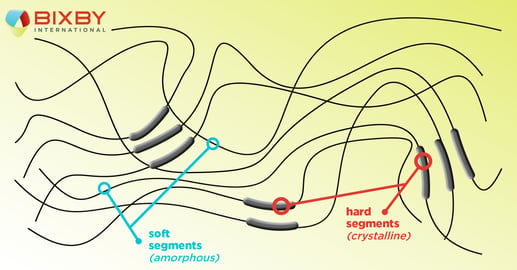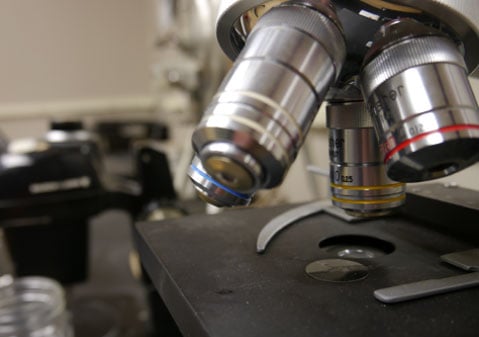Which TPU is for You?
Choosing the right TPU grade for your application
Whether your company manufactures medical devices, sneakers, or auto parts, you know that raw material selection is crucial to your product’s success. At Bixby, our team of experts draws on over 140 years of materials knowledge, helping us thoroughly understand our customers’ applications, and choose the right materials with the optimal balance of cost and performance.
We are proud of our ability to extrude or laminate just about any polymer under the sun. TPU—thermoplastic polyurethane—is an ideal choice for many demanding applications, given its strength, toughness, and resistance to a wide variety of chemicals. As more designers and engineers discover the benefits of TPU, its number of applications is quickly expanding. You may already be familiar with some of these brands:
Supplier |
Brand Names |
BASF |
Elastollan® |
Covestro |
Desmopan® & Texin® |
Huntsman |
Avalon®, Irogran ®& Krystalflex® |
Lubrizol |
Estane®, Pearlbond™, Pearlthane™ |
Versatility is the key word when it comes to TPU. It’s not just one material: by altering the chemistry, scientists create countless variations that find a home in just about any application.
- Available in a wide range of hardness levels, from soft and gel-like to hard and rigid
- Strength, toughness, and elastic resilience can be varied to suit application
- Easy to expand useful properties by blending with other plastics, colors, and additives
- Biocompatible grades exist for medical applications (ISO 10993 and USP Class VI available)
How does TPU work?
The secret of TPU’s popularity lies in its chemical structure. It is synthesized by the polymerization reaction between the following ingredients (monomers):
- Long-chain diol
- Short-chain diol (the chain extender)
- Diisocyanate
The diols react with the diisocyanates, creating urethane bonds. Areas rich in long-chain diols are called soft blocks — because the longer chains make these domains more soft and flexible. The hard blocks, consisting of the short chain extenders and diisocyanates, pack closer together and give TPU its toughness and elasticity.

These “hard” and “soft” phases are what make TPU a versatile thermoplastic elastomer, or TPE. The hard blocks form crystalline domains that act as physical crosslinks, lending the polymer its superior mechanical properties. But unlike chemical crosslinks, like those in rubber or silicone, physical crosslinks can be melted down and re-form, and this property is what allows TPU to be extruded, molded, or thermoformed.
Choosing a TPU Grade
When choosing raw materials, it’s important to consider what the environment of the final part will be. Will it be indoors or outdoors? Will it be in contact with moisture? What will the ambient temperature be? What other materials must it adhere to? Asking these questions early in the product development process will help narrow your search and move the project forward quickly.
Broadly speaking, TPUs can be broken down into two main chemical classes: polyester and polyether-based. Since the chemistry dictates the behavior of the plastic, this is a good place to start when choosing a grade.
- Polyester TPUs are synthesized from polyols that contain ester groups. This class of TPU possesses superior mechanical properties, including abrasion resistance, chemical resistance, and tensile strength. The ester group in the polymer backbone also makes these grades particularly compatible with other polar plastics, like PVC or ABS.
- Polyether TPUs are made from polyols that contain ether groups. The resulting chemistry makes these grades hydrolysis- and microbe-resistant. That means polyether TPUs are ideal for medical applications applications where moisture and bacterial growth are concerns. They are not quite as polar as the polyester grades, making them more compatible with nonpolar substrates. Plus, they are better at maintaining flexibility at low temperatures than ester-based TPUs.
Almost all commercially available grades of TPU fall in one of these two categories, but there exist specialty grades outside of this continuum. Polycaprolactone-based TPUs, for instance, combine the strong mechanical properties of ester grades with the low-temperature flexibility of ether grades.
TPUs are also available in aromatic and aliphatic grades. This refers to the chemistry of the diisocyanate. There are a lot of variations and exceptions, but generally speaking:
- Aliphatic TPUs offer excellent clarity and will not yellow when exposed to light, making these grades ideal for glass lamination and outdoor applications.
- Aromatic TPUs are more common, workhorse grades. They offer the best abrasion resistance and tensile strength. The double bonds in the polymer backbone, however, means it will degrade over time due to UV light and oxidation. Luckily, certain additives can slow this process.
Whether you’re looking for durability, elasticity, or chemical resistance TPU is an excellent choice. But this is only an overview: there has been a great deal of innovation since TPU was invented in 1937, and there is still so much more to go.
Related Pages
Materials - Polymers & Custom Extrusion
Materials - Substrates & Custom
Blog by Jeff Raymond (R&D)


